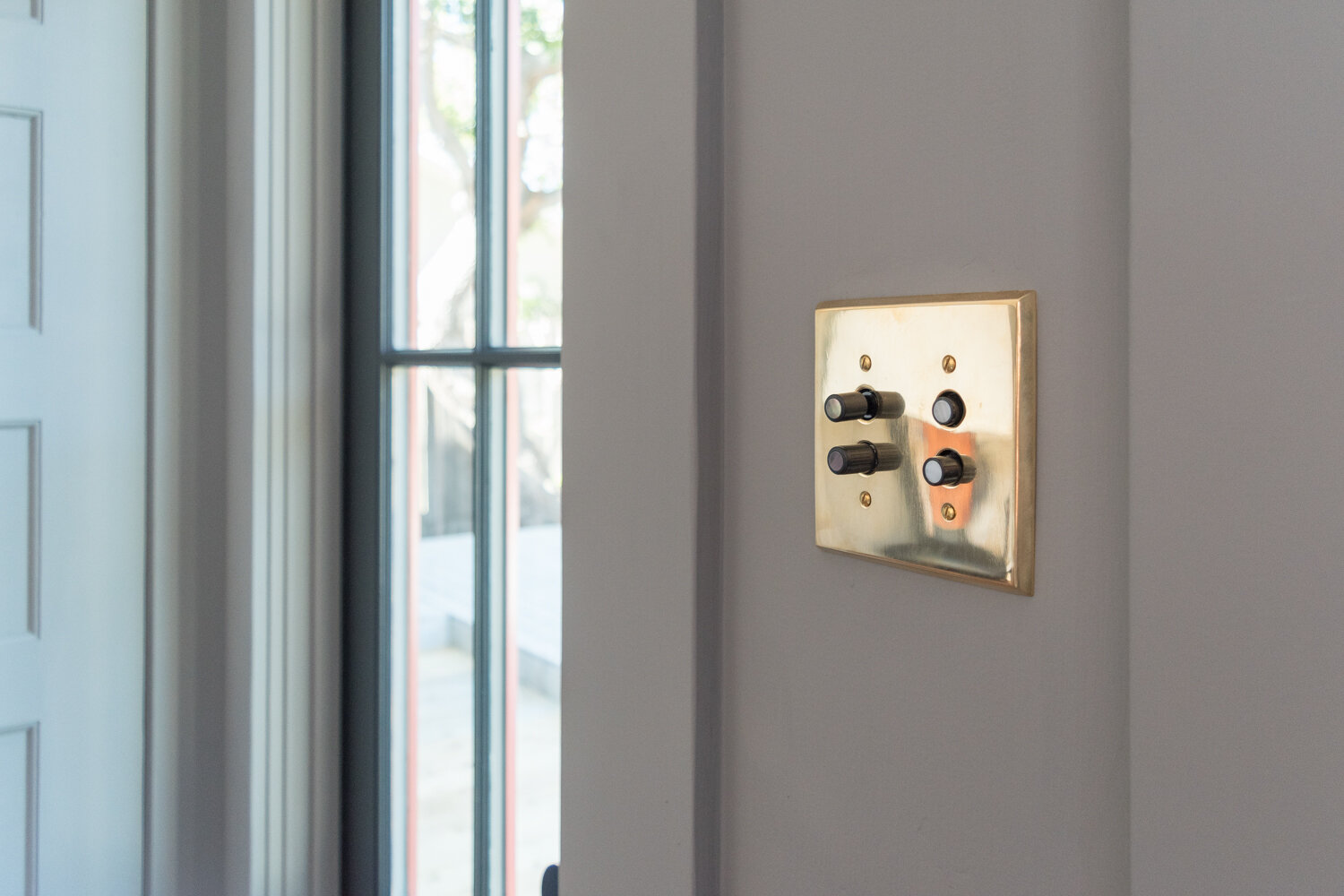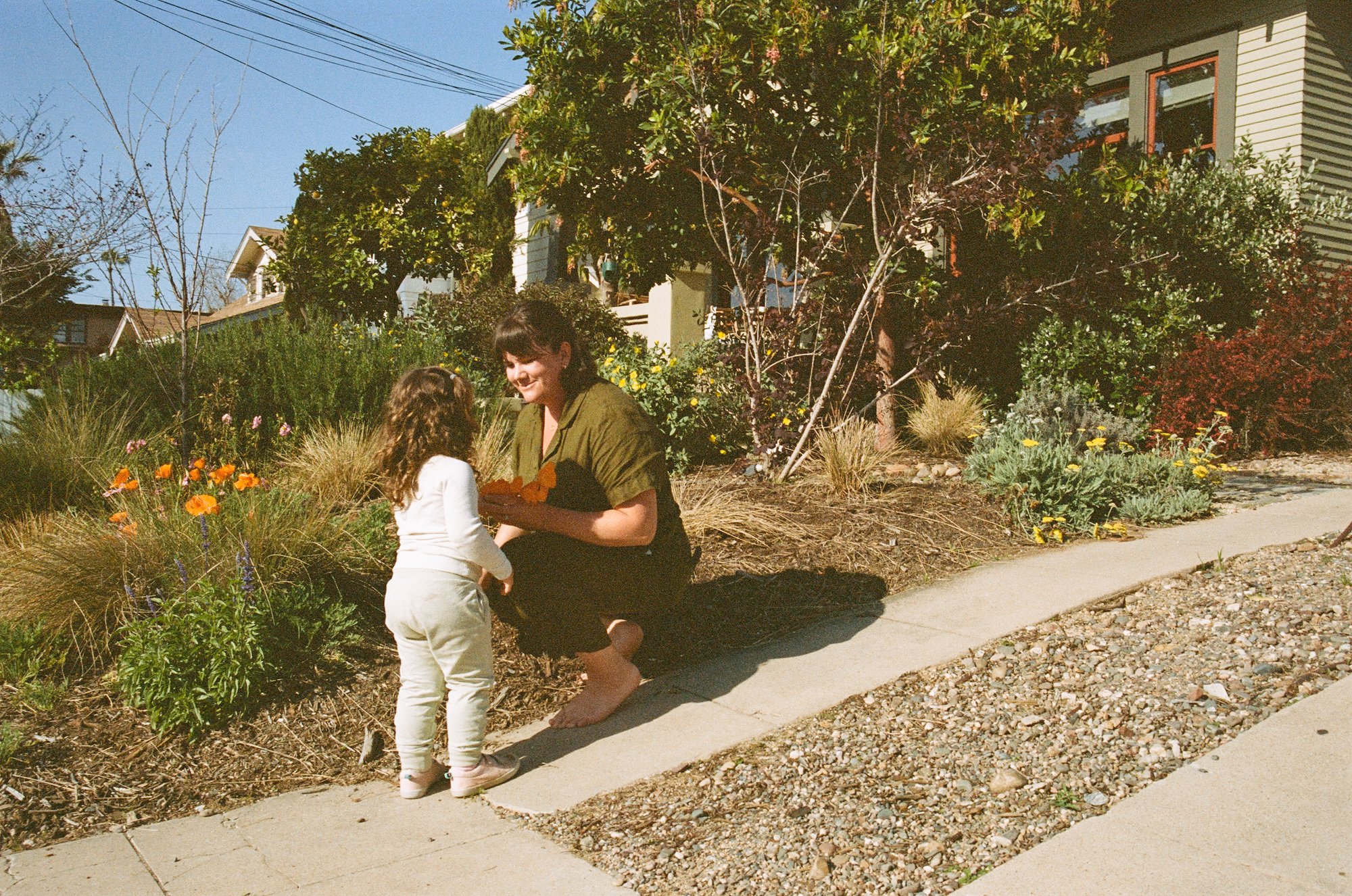All About Push Button Light Switches
/I’m a big fan of my light switches - just those simple dimple little things we use every day. And I get asked about them a lot, so I want to share a little about those brass, black, and pearl things you see on all of my walls. I’m here to tell you about my period-appropriate light switches!
There are oodles of types of light switches out there. Nowadays, the popular ones are big rectangles that are touch-sensitive like our phones, but before that, we had rocker switches, before that we had the toggle, and before that, we had the push button. I’m not going to pretend to give you a history of light switches, so you can read up on that yourself. All I’m saying is we chose to install old school light switches that would have been originally installed in our 1915 home.
Before moving into our house we had all of the electrical re-wired for safety and since we were retexturing the walls already. The house originally had knob-and-tube which people like to say is soooo dangerous. Knob and tube can be dangerous, but I’m of the opinion that the shoddy modifications to the wiring over the years were far more dangerous. There were live wires in the walls and the outlets were spliced and daisy-chained in a fashion that made our electrician wince. Anyway, we ran all new electrical which meant we installed and removed a few switches and outlets and had to replace the switches we had.
When given the opportunity to update all of the switches, we had to decide if we wanted newfangled gadgets or period-appropriate buttons. Well, you already know that we chose the push buttons. I simply love the look, and I adore the way they feel. Much like the satisfying click of typewriter keys or an antique elevator, there’s a quality to the feel of the click. I also like that we can easily find the light switches so there’s no fumbling for them in the dark.
I put together a very brief video where you can hear and see the click as well as admire the patina on the brass plates, which I’ll talk about in a second.
Video:
When we installed these switches five years ago, there were some fancy light switch options but not like the ones we have today. They are pretttttty fancy in 2020. If we were doing the update today, we might consider the fancy switches that Garrett and Cathy installed in their kitchen. The newfangled gadgets sound pretty cool - setting them on a timer to go on each morning and automatically dimming into a warm hue at night all sounds lovely. But, I love our simple on and off switches. I appreciate the way they serve as jewelry for my walls and ooze the old house charm we all adore.
Things to think about when getting any kind of switch:
Dimmer: We did spring for the added feature of dimmers on most all of our switches. I’m a fan of the dimmer! The beauty of having dimmers is that you can get a really bright bulb, then adjust how much light you want it to put off on any given day no matter the time, weather, or mood you want inside. With low-energy LED bulbs, there’s really no reason not to. The dimmer switches do cost more, so we don’t have them throughout, but we’re pleased with the distribution. Note that the dimmers have a slightly different operation and look to the traditional switches. See it in the video above. Instead of one button for on and one for off, the dimmers operate with the top button being the on and off, and the bottom one twists to adjust the brightness.
Three-way switches: Several of our switches are on three-way switches. This means we have one overhead light, but two switches - one at each door into the room to control the one light. You probably have one a three-way switch in your house at each end of the hall or next to each entry into the dining room. Three-ways are great and not complicated to install, but only one of the three-ways can be a dimmer. So plan your shopping cart accordingly. (This goes for all traditional light switches, not just push-buttons)
Aesthetic of switch: Push buttons often come with a couple of options for the button. I opted for the classy ones with mother-of-pearl inlays which have that pearlescent white shine to them. If you didn’t want this, you could get just the plain black ones.
Aesthetic of plate: Brass was a popular metal finish in homes like mine (craftsman bungalow from 1915) so we embraced the pretty hue. Original brass from one hundred years ago looks like a very dark brown because of the patina as the metal has aged through the years from oxidation and all of the oils of our hands touching the plates. So, depending on your look, you might want to get the shiny brass that would have been enjoyed in 1915, or you’d want an antiqued brass as the house aged after a decade or so. You can buy antique brass finishes, but they don’t have the same umph to them. So I bought un-lacquered brass to let the metal age naturally. Un-lacquered means that the metal hasn’t been given a protective coating to keep it looking shiny and golden. Instead, it will patina over time and darken over the years because it doesn’t have any protective finish. I have plates that are 5 years old and definitely looking aged, and I have plates that are 2 years old and they’re starting to age but definitely look like they’re in the awkward teenager phase of growth. You can see the difference in the video above. For the bathroom I got a white metal plate to blend in with the white tile. While the brass plates stand out, I’m also all for having plates blend in with the walls.
Don’t forget outlets: We opted to match the outlets to the switches. The plugs are black and the plate is the same un-lacquered brass as the switch plate. Most of our outlets were in the baseboard which is more traditional, so we left them there. Nowadays, we don’t install outlets that low for accessibility reasons (it’s harder to lean that far down) so we have a mix of some outlets in the wall.
Get the right bulb: You might think that I’m about to recommend the Edison style light bulbs with the exposed filament. But, I actually prefer a frosted bulb. The clear bulbs with the bright filament are sometimes too bright and I prefer a more diffused light. However, in the right application, those retro bulbs sure are pretty - and they come in oodles of styles and LEDs, too! I personally like a warm 2700 Kelvin bulb. You could go for 3000 if you like, but I don’t recommend going any cooler!
Where to buy: Several retailers carry push button switches and plates. You can shop around to find the ones that cary the plate colors you want, offer the all black or the mother-of-pearl inlays, or have the best promo and price. I like Rejuvenation, Kyle Switch Plates, Killian Hardware, and House of Antique Hardware but you can also go to Classic Accents or even Amazon.
I can’t put your whole shopping cart together since I don’t know your lighting plan, but Rejuvenation and House of Antique Hardware will definitely have you covered on a variety of switches, covers, and options for making your house look perfectly period-appropriate. You can also hunt architectural salvage shops for plate covers!
I think that’s about it! Let me know if you have any questions about my push button light switches in the comments below!































